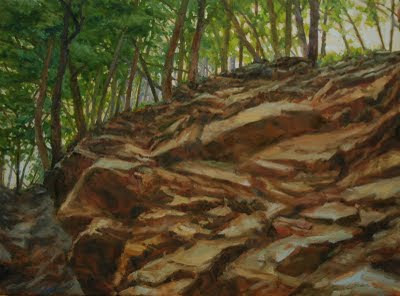Morning Rocks
oil on canvas 28" x 38"
It seems to me that, in order to make paintings that might be considered visually powerful or at least effective, a painter must be a functioning split personality. The French poet, Paul Valery, knew Degas late in the master’s life and paraphrased a key piece of knowledge passed along from the old man.“True seeing is the forgetting the names of the objects seen.”
Every painter must discover this to be true at some point or the work can never progress beyond imitation or illustration - and into the realm of art - making.
Lately I have been reading two books that relate first hand stories about Cezanne and his working methods. In a synopsis of many conversations related by Joachim Gasquet, a friend of Cezanne’s since childhood and a writer and poet, Cezanne speaks of his approach to the complexity of the visual world. While Degas and Cezanne are so different in personality, life style, and artistic approach - they both have come to similar conclusions.
“Nature is always the same, yet nothing we see endures. Our art must convey a glimmer of her endurance with the elements, the appearance of all her changes. I pick her tonalities, her colors, her nuances,... they become objects, rocks, trees, without my thinking about them,... if I get carried away with theory, if I intervene, then bang! All is lost; everything goes to hell”
This is a wonderful explanation of the act of painting, but Cezanne was such a complex man, sometimes seeming to be contradictory about every aspect of his art, it can be confusing to read him. He admonished young artists to think and consider cylinders and spheres and cubes within the subject - this was often misinterpreted - but if you read carefully a division of when to ‘intervene’ with thinking and when not to becomes clear. Preliminary to the act of painting one must stop and think; “Why have I chosen this subject? What have I fallen in love with? Where is the poetry found in this ‘motif’?” Then the artist forgets what the thing-ness of his subject and proceeds. A split personality in action, eh?
Yet thinking is essential to color and influence the subsequent immersion in the act of painting. The thing that writers who knew him seem to agree on was this; Cezanne was driven every day to paint and struggle with the difficulties of being this simultaneous dichotomy - one who thinks and feels and fights to record the impossible beauty of his world, The idea that there were no contours explaining 'things' - only elements that danced, ever always changing before him - this was his obsession. Presented here, 'Morning Rocks', is my latest attempt to follow, in my own way, the same path. Enjoy!

No comments:
Post a Comment